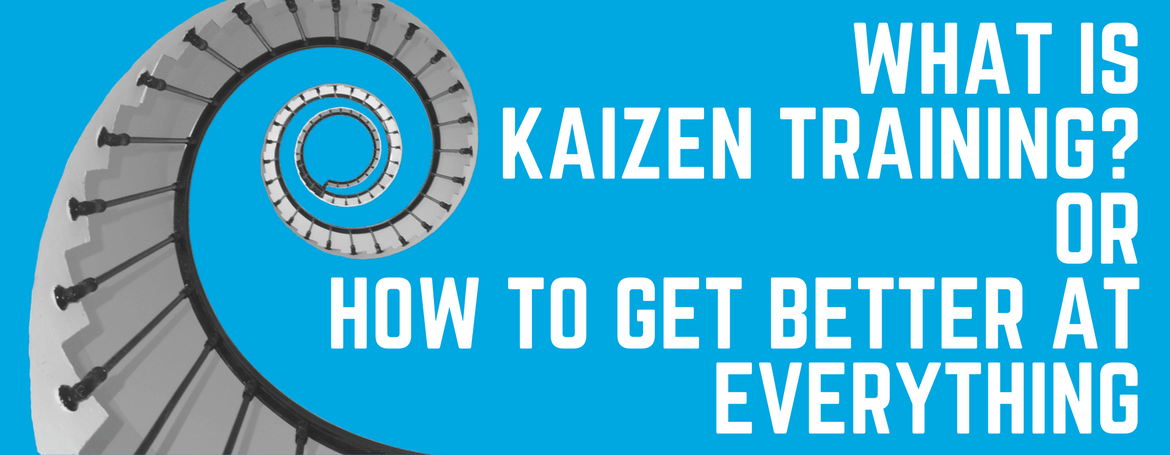What is Kaizen Training? or How to Get Better at Everything!
The Japanese Training and Philosophy from Continual Improvement August 28, 2017What is Kaizen?
Kaizen is a Japanese philosophy of continuous improvement of your work. Kaizen can be simply translated as “improvement” (kai = change, zen = good). But as many other Japanese hieroglyphs, it does have a deeper meaning than that. Let’s take a look at the two hieroglyphs:
Kai is formed from two words: self + whip. Which implies you are the only person that can change you. Nobody else can do that, no matter how hard they try. The real change comes from within. Kai is another word for “revolution”. Which suggests that this is not a small change, but a big one.
Zen is also formed from two words: sheep + altar. Or, said in other words, it means a sacrifice.
So if we can sum up the deeper meaning of Kaizen – Push yourself to the limit and make a sacrifice when it’s needed.
Kaizen and the Business World
Аfter the World War II in attempts to rebuild Japan’s economy, the idea of Kaizen was born. Toyota was the first business to implement those changes. The company proved to the rest of the world that this business model works. They claim that Kaizen is in the management base. To this day they swear by it and say they owe their success to Kaizen.
But Toyota isn’t the only business that profited from Kaizen. A lot of other Japanese manufacturers also followed their lead like Komatsu and Toshiba. Many hospitals, hotels and IT companies started applying it too. Kaizen is gaining popularity outside Japan. India, Thailand and Taiwan are just a few examples. The key is to strive for improvement every day down to the last small detail. Japan is known worldwide of their flawless manufacturing. Below you can find a video showing the Kaizen method in action.
Kaizen is a team effort and all about empowering the workforce, humanising them. Everybody in the company, from the top to the bottom positions, take part in improving the processes.
There are two distinguishable approaches to do that:
Flow Kaizen – Focus on the overall value system. The improvement of the flow of materials and information.
Process Kaizen – Focus on the individual processes. The improvement of specific work processes.
To have a long-term positive effect both approaches have to be applied.
Advantages of Kaizen
How can Kaizen help a business?
Companies which apply Kaizen can expect:
- Productivity raise.
- More satisfied clients.
- Happier team members.
- To be more competitive.
What to watch out for:
- To be focused only on big change. When people focus only on the big changes they tend to close the doors to different opportunities which could turn out to be very successful. You never know what will be the next big thing. Just remember: Small and trivial Kaizen. > Big important innovation.
How can Kaizen help you?
Applying Kaizen to your work will:
- Eliminate “waste”.
- Improve teamwork.
- Improve your enthusiasm.
What to watch out for:
- Fear. Eliminate fear as it blocks creativity.
Those small trivial moments can make a big difference.
Kaizen can be applied in your daily life too. As you may already know, Japanese women have the longest life expectancy in the world – 87 years. It is believed it’s due to “optimising” their way of life.
The four steps to Kaizen and how to apply them
Plan. At work, as in life, we have to set goals to succeed. Without goals, we’ll be aimlessly going on and about. You cannot achieve something if you don’t know what you’re after. Brainstorm the whole process – what you want to achieve, how do you plan to accomplish that, what outcomes do you expect. Think of what small steps you can make get better at whatever you’re aiming at. Write them down. Start with a plan of what you want to change, what do you need to achieve it and who is going to do it. Make your to-do-list. It should include who is assigned for which task, when do you need to get it done and what resources do you need.
Do. This is the implementation part. Execute the plan you made, analyse the results, collect the data so you can proceed to the next step.
Check. This is the time for a review. Evaluate the results. Is everything according to plan? Is there something you can fix along the way?
Act. If the newly implemented changes are showing the expected results, then it should become the new standard. If the results differ from the expectations, whether they’re good or bad, you should get back to step one – Plan.
Kaizen as Both Training and Philosophy
Success isn’t made out of big ideas only. It’s also made out of those small everyday achievements. But they do need to keep coming. Small improvements without a direction won’t be helpful and they won’t provide the expected results. All improvements have to align with the company policy. It gives a sense of direction.
The good thing about the Kaizen approach is that you aim for small steps every day. Do your first step today.
At Fantastic Services Franchise we’ve adapted this work philosophy.
“Don’t put off until tomorrow what you can do today.” – Benjamin Franklin
When a company wants to incorporate the Kaizen method in their work, it has to options: incorporating it on their own or hiring a consultancy agency to hold a training. If you want to take a course, there are a few options* in Australia: Shinka Management – Kaizen Foundation Series, Kaizen Practitioner at The Knowledge Academy, AuSQ Lean Practitioner, Professional Development Training.
*Not sponsored.














